Exploring Bottle and Wine Openers: Design and Function
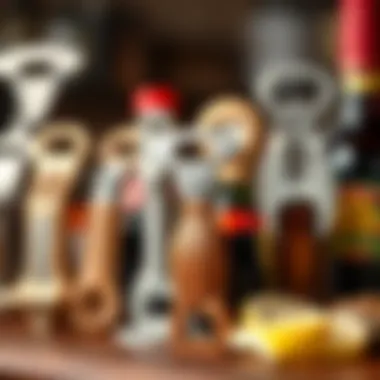
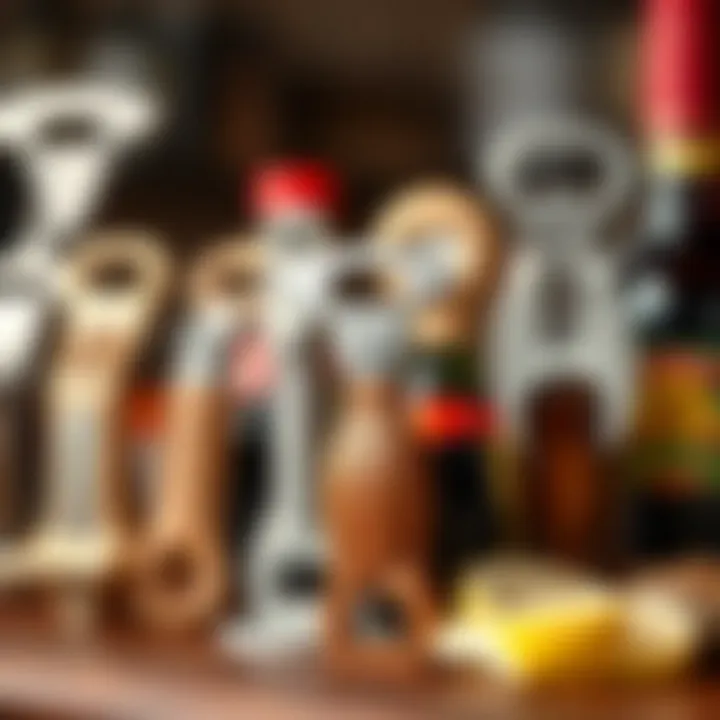
Intro
In a world rich with tradition and creativity, the humble bottle opener stands as a testament to the fusion of functionality and design. This unassuming tool serves a vital role not only at social gatherings but also in moments of solitary pleasure, like savoring a glass of fine wine after a long day. Often overlooked, corkscrews and bottle openers have evolved over centuries, reflecting changes in society and technology while also embracing artistic flair.
This exploration will take you beyond the mere mechanics of opening a bottle. Herein lies a deep dive into the various forms these instruments take, the materials that compose them, and how their designs cater to specific needs. From the classic corkscrew to the inventive electric openers, each has a story, a purpose, and a place in our lives.
Moreover, we'll examine the interplay of craftsmanship and ergonomics in creating openers that not only work well but also feel good to use. As we navigate through their historical context, aesthetic variations, and practical applications, the narrative will cater to both the casual drinker and the discerning connoisseur. Together, we’ll uncover the nuances of selecting the ideal opener for various types of bottles—turning what might seem a simple task into an informed, enjoyable experience.
Preface to Bottle and Wine Openers
Bottle and wine openers, while often overlooked, play a pivotal role in the world of beverage enjoyment. The act of opening a bottle—whether it's a vintage Cabernet Sauvignon or a craft beer—serves as both a practical need and a ceremonial gesture. The accessibility and ease provided by these tools can significantly enhance the experience of savoring what’s inside.
Understanding the different types of bottle openers available today can empower both casual drinkers and serious connoisseurs. Each design serves its unique purpose, catering to various preferences and bottle types. It's not just about getting the cork out; it's about elevating the experience, ensuring every sip is as intended.
What stands out is the evolution of these tools through time and culture. From simple folk methods to exquisitely crafted pieces, openers are reflections of both artistry and functionality. The varied materials used—ranging from stainless steel to innovative biodegradable plastics—highlight how design intertwines with sustainability and utility.
When selecting the right opener, one must consider factors such as bottle type, personal style, and even frequency of use. The wrong tool might lead to frustration or, worse, a broken cork. Thus, knowing the ins and outs of these instruments can make all the difference.
"It's not just about opening a bottle; it's about opening a world of flavors and stories within each pour."
In this article, we will explore the diverse types of bottle and wine openers available, delve into the materials that make them work, and examine their historical evolution. By the end, you'll not only know which opener best suits your needs but also gain an appreciation for the craft behind these essential tools.
Types of Bottle Openers
When it comes to enjoying a well-deserved drink, the type of bottle opener you have can really make a difference. The right opener not only helps you access the delicious contents inside but also reflects the drinker's style and preferences. Various designs cater to different needs, from simple hand-held tools to complex, multifunctional gadgets. This section will delve into the different types of bottle openers available and why choosing the right one matters in your wine and beverage experience.
Corkscrew Designs
Corkscrews are the most recognized tools for opening wine bottles. With various designs, they serve different purposes while also considering ease of use and aesthetics.
Traditional Corkscrew
The traditional corkscrew, the one most people envision when they think of a wine opener, consists of a metal helix attached to a handle. This design proves to be timeless. Many appreciate its simplicity and effectiveness.
One of the biggest advantages of a traditional corkscrew is its lightweight nature. You can easily carry it around in a pocket or bag. Its straightforward mechanism makes it a go-to for those who enjoy wine casually and want a no-fuss opener. However, it does require some skill to ensure you don’t break the cork, especially with older bottles.
Lever Corkscrew
Next, we have the lever corkscrew, which stands out due to its user-friendly mechanism. This type operates with a lever-activation design, allowing users to effortlessly extract corks without much strength.
This design is especially beneficial for older individuals or those with wrist issues, providing a more accessible option. The sleek look and ease of use make it popular among both novice drinkers and seasoned connoisseurs. However, their slightly bulkier construction may not suit everyone’s taste when it comes to convenience in packing.
Electric Corkscrew
Lastly, the electric corkscrew has made quite an impression, particularly with tech lovers. With just a push of a button, this battery-operated opener removes the cork in a matter of seconds.
These devices are gaining traction because they are particularly beneficial for people who frequently host gatherings. The ability to pop open multiple bottles quickly ensures the party keeps rolling. The only drawback might be the higher price point and dependence on battery life.
Wine Bottle Openers
Wine bottle openers come in various forms that cater to different preferences and occasions, and understanding these variations enhances the overall experience.
Waiter's Friend
The Waiter’s Friend is a classic among wine openers, featuring a corkscrew, a knife for cutting foil, and a lever. It's compact and versatile, making it a favorite for both restaurant professionals and home users.
Its multi-purpose nature means you won't need an extra tool for foil cutting, making it a convenient option for those looking to streamline their wine-opening process. However, some may find it takes a bit of practice to master its use effectively.
Ah-So Opener
The Ah-So opener is another interesting choice. It consists of two pronged blades that slide between the cork and the bottle neck. This tool excels at removing corks without damaging them, which can be crucial for vintage bottles.
Wine enthusiasts often appreciate its effectiveness at keeping corks intact. That said, using it can be a bit tricky for those unfamiliar with the technique.
Twist-Top Bottle Openers
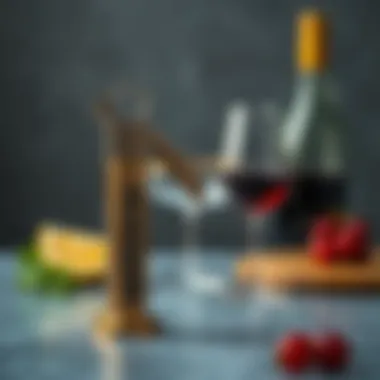

Twist-top openers, while not technically just for wine, have found their place in many households due to their convenience. They cater to bottled beers and other beverages featuring twist caps.
For casual drinkers, they’re a must-have. Very easy to use and perfect for picnics or casual get-togethers, twist-top openers are functional and entertaining to use. However, they lack the sophistication that some wine lovers might seek when dealing with bottles of fine wine.
Multifunctional Tools
Multifunctional openers combine different functionalities that can enhance the overall drinking experience. These tools can offer a unique blend of benefits.
Bottle Openers with Built-in Knives
Some bottle openers come equipped with built-in knives, providing a complete tool for the task at hand. This design can be especially useful for those who enjoy outdoor activities, allowing for easy bottling and food preparation.
The advantage here is the convenience of having multiple tools in one, minimizing the need to carry excess gear. Some people may find that a combined tool, though handy, may not work as effectively as dedicated devices do.
Keychain Bottle Openers
Another nifty option is the keychain bottle opener. These miniature openers are often compact and easy to carry, making them a fun and functional accessory.
Their small size means they can fit right onto your keys, ensuring you’re never far from an opener. While they might lack some leverage compared to larger models, they provide solid functionality in a pinch.
Opener and Pourer Combo
Finally, we've got the opener and pourer combo, a marvel of convenience. This opener not only removes the cork but also allows for precise pouring.
This can be a game-changer for those who enjoy hosting wine tastings, as it offers both easy access and a delicate pour. The downside is that the complexity of the design may deter some users who prefer straightforward tools.
Materials Used in Openers
The choice of material for bottle and wine openers plays a crucial role in their functionality and design. This section will explore various materials and their contributions to the long-term usability of openers. Understanding the characteristics of these materials can help consumers make informed decisions based on durability, style, and cost-effectiveness.
Metal Openers
Stainless Steel
Stainless steel is highly regarded in the world of bottle openers. Its innate corrosion resistance makes it a top pick among manufacturers. With its durability, stainless steel can withstand wear and tear better than many other materials. It is especially beneficial for those who may have a heavy hand when handling openers.
A unique feature of stainless steel is its ability to remain aesthetically pleasing over time; it doesn't easily tarnish. However, this material can sometimes be heavier than others, which might be a trade-off to consider for some users.
Aluminum
Aluminum is another favorite in the realm of bottle openers. Featuring a lightweight composition, it is often used in travel-oriented or portable designs. This material is less dense compared to stainless steel, making it favored by those who want an opener that won’t weigh down their bag during picnics or parties.
One standout characteristic of aluminum is its resistance to rust and corrosion, but it can be more prone to dents and scratches. It's important to weigh those disadvantages against its affordability and lightweight design—great for the casual wine drinker.
Plastic and Composite Openers
Durability Considerations
When it comes to durability, plastic and composite materials can offer surprising resilience. A well-designed plastic opener can withstand considerable stress without cracking or breaking. Durable plastic offsets its less-than-stellar image as a flimsy material. Some high-quality varieties even mimic the durability of metal, making them an attractive option for those who want affordable alternatives.
Cost vs. Functionality
Plastic often shines when one considers cost versus functionality. These openers are typically less expensive, making them an ideal choice for casual users or those new to wine exploration. However, it's crucial to note that while price might be appealing, one must consider how frequently they will use these openers, as that will directly affect their longevity. Frequent users may prefer investing in sturdier options.
Innovative Materials
Biodegradable Plastics
As sustainability becomes more significant, biodegradable plastics are getting some attention. They offer the eco-friendly appeal that many consumers are now seeking. These materials can break down naturally without leaving harmful residues, appealing to environmentally conscious wine lovers.
Biodegradable plastics also showcase the same light weight of traditional plastic, though they might not hold the same durability. For those who prioritize eco-friendliness over longevity, these openers represent a valuable option.
Carbon Fiber
Carbon fiber has begun to make inroads into the world of bottle openers, pushing the boundaries of what materials can be used. Known for its impressive strength-to-weight ratio, carbon fiber allows manufacturers to craft openers that are not only lightweight but also incredibly durable. The sleek appearance adds a modern touch, enhancing the aesthetic quality.
However, the main drawback of carbon fiber openers is their higher price point. While they bring many advantages, potential buyers should consider if the benefits align with their personal preference and budget.
Historical Evolution of Bottle Openers
The historical evolution of bottle openers reveals much about societal changes, technological advancements, and cultural shifts over centuries. The journey from simple tools to complex designs showcases humanity's unyielding quest for convenience, as well as their appreciation for craftsmanship. An examination of this evolution not only highlights the practical benefits these tools offer but also underscores how they became intertwined with social rituals surrounding the enjoyment of beverages. The designs have varied significantly, catering to different needs and preferences, thus creating a fascinating tapestry of history and innovation.
Origins of Bottle Openers
The origins of bottle openers trace back to ancient times when bottles, often made of materials like clay or glass, necessitated some ingenuity to access their contents. Early bottles featured corks, and as history unfolded, the simplicity of just pulling out a cork evolved into a need for tools to simplify the task. In the 17th century, we see the birth of more specialized tools designed specifically for opening bottle stoppers.
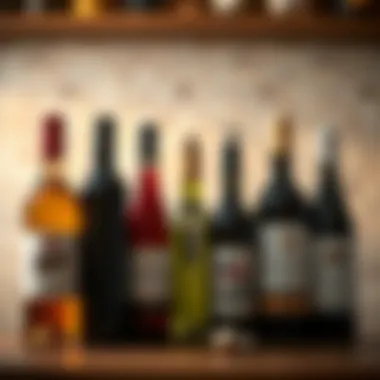

For example, the family of corkscrews emerged during this period, marking a pivotal point in bottle-opening history. Initially, these tools were rudimentary, resembling nothing like today’s sophisticated corkscrews. They required a fair bit of muscle and skill. The invention of the corkscrew is often credited to various inventors from different parts of Europe, each contributing to what we understand as an essential dining tool today.
Key Innovations and Patents
As the centuries rolled on, so did significant key innovations shaping the functionality of bottle openers. The late 19th century saw a flurry of patents—many fueled by the rise in wine consumption and the burgeoning beverage industry. Notably, the mechanism for the lever corkscrew was patented in 1870 by a man named Elijah McCoy. His design, often regarded as more user-friendly, spurred many variations that followed.
Meanwhile, an innovation that truly made waves was the introduction of the waiter's friend in the early 20th century. It combined various functions into one compact tool—no longer did wine enthusiasts need multiple gadgets to tackle different tasks. This era also saw the rise of electric openers; bringing a modern touch to an age-old challenge.
"Innovation doesn’t end with a single product. It opens doors to further creativity and refinement of design."
Cultural Significance
Bottle openers are not merely functional tools; they have developed cultural significance that reflects varying traditions and communal practices. In many regions, opening a bottle is a social event, whether it be a celebratory toast or a casual gathering. The design of the opener often bears symbolism, with certain styles reflecting artisan skills passed down through generations.
For instance, in countries where wine holds cultural importance, ornate bottle openers crafted from high-quality materials often become treasured heirlooms. Consider Italy, where the rich history of winemaking is echoed in the hand-produced corkscrews that artisans create. They are not only functional but symbolize the love and skill involved in winemaking itself.
In modern cultures, bottle openers even find their way into gift items or souvenirs, encapsulating memories from travels or celebrations. Their role has shifted from mere utility to a marker of shared experiences, representing conviviality, relaxation, and moments spent with loved ones.
In melding together these threads of history, innovation, and cultural depth, the bottle opener stands testament to humanity's adaptive spirit, revealing insights into how a simple tool can evolve to meet both practical needs and social desires.
Design Considerations
When selecting a bottle or wine opener, design considerations play a crucial role in both functionality and aesthetics. It’s not just about how it works; how it looks and feels in the hand seems to make all the difference. The design of an opener affects user experience, making it more enjoyable and accessible. As we dive into this topic, we recognize that thoughtful design can enhance the utility, comfort, and attractiveness of these everyday tools.
Ergonomics
Ergonomics in opener design refers to how comfortably and effectively a user can handle the tool. A well-designed opener reduces strain on the hands and wrists while maximizing leverage for easier cork removal. For instance, models with a contoured grip or anti-slip surfaces can significantly improve overall handling. This consideration is particularly important for those who might have difficulty using standard openers, such as individuals with arthritis or limited grip strength. In terms of practicality, investing in ergonomically designed openers often translates to less frustration and a quicker, smoother opening process.
Aesthetic Trends
Minimalistic Designs
Minimalistic designs focus on simplicity and functionality, stripping away the excess to achieve an elegant form. A key characteristic is the use of clean lines and neutral colors, promoting versatility in any setting. For many, these openers are more than tools; they represent a lifestyle choice where form meets function. Minimalism’s appeal lies in its unobtrusive nature, easily blending into various kitchen or dining decors while still being efficient. However, some may argue that minimalistic designs can lack personality or uniqueness.
Artisan Craftsmanship
Artisan craftsmanship brings to the table a unique blend of skill and individuality. Openers made through traditional techniques often showcase exquisite detail and creative flair. A standout feature of artisanship is the integration of various materials, like wood or handcrafted metals, which tell a story about their creation. These openers not only serve a purpose but also become conversation starters, reflecting the culture and artistry behind them. But artisan-crafted openers can come with a steeper price tag, which may be a consideration for budget-conscious buyers.
Customization Options
Customization can turn a simple opener into a meaningful gift or a cherished possession. Many manufacturers offer personalized engravings, allowing for initials, dates, or special messages to be inscribed on the handle. This aspect adds a personal touch that can elevate the item from a mere tool to a treasured keepsake. Personalized engravings cater to those looking for a heartfelt touch while gifting. Positive features include not only making the opener special but also providing a sense of individuality. However, customization may delay the delivery, making many customers rethink their timing.
Color Variations
Emphasizing thoughtful design can significantly enhance the user experience, making everyday tasks, like opening a bottle, a pleasure rather than a chore.
With these design considerations in mind—ergonomics, aesthetic choices like minimalism or artisan craftsmanship, and the possibilities of customization—consumers can find an opener that resonates not only with their practical needs but also with their personal style.
Functionality and Practicality
When it comes to bottle and wine openers, functionality and practicality are the linchpins that hold the entire subject together. Every bottle opener, from a simple corkscrew to a high-tech electric model, serves a vital purpose: to access the contents inside a sealed bottle. Understanding how these tools function and their practical applications can significantly enhance the wine and beverage experience. This exploration looks beyond mere aesthetics; it seeks to pinpoint how design influences usability and efficiency.
Ease of Use
The ease of use is paramount. When it comes to opening a bottle, no one wants to wrestle with their tool, especially after a long day. Openers should serve the purpose of removing a cork or cap without turning the task into a complex operation. For example, consider the classical waiter's friend opener – it’s small, handy, and just a twist and pull away from getting the wine flowing.
Moreover, electric corkscrews take the cake for simplicity. Imagine hosting a gathering where guests eagerly await a bottle of vintage red. You reach for your electric opener, press a button, and voilà! No fuss, no mess. This ease can be a game changer, especially in social settings where quick access to beverages matters.
Effectiveness Across Bottle Types
Standard Wine Bottles
Standard wine bottles are the bread and butter for wine aficionados. Their commonly used cork closures are familiar terrain for most bottle openers. These bottles typically have a neck diameter and cork height that accommodate a variety of corkscrews effectively. This predictability makes standard bottles a beneficial anchor point in any discussion about bottle openers.
What’s unique about standard wine bottles is the cork size, allowing for a solid grip with many opener designs. You can employ a handheld corkscrew or even a lever-type opener without facing many challenges. Furthermore, the broad compatibility with various opener types underscores the simplicity of decanting your wine. However, a downside may arise with older corks that can crumble or break, at which point the right opener is crucial to salvage the bottle’s contents.
Craft Beer and Specialty Bottles
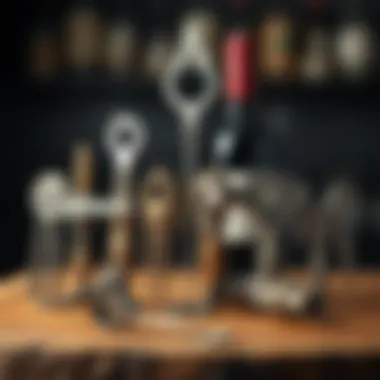
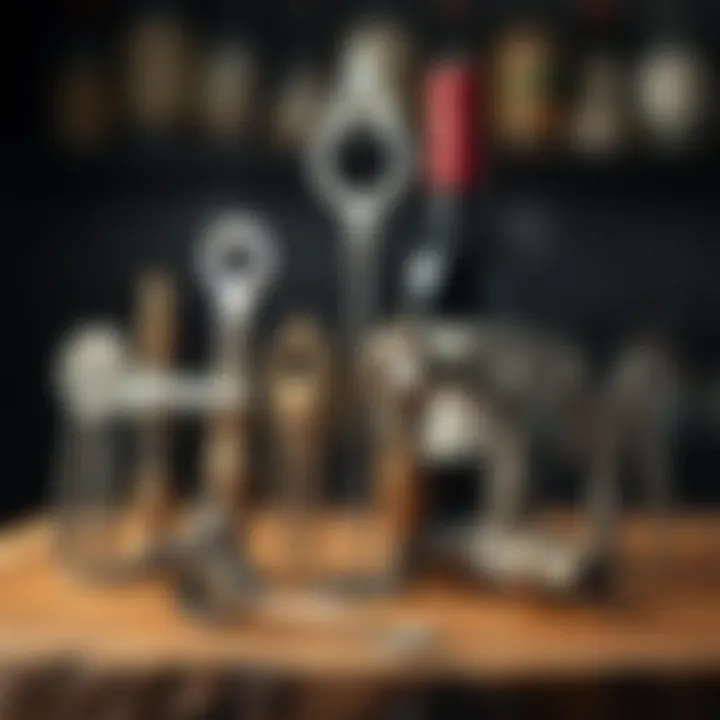
Craft beers and specialty bottles present a different challenge altogether. These vessels often deviate from the standardized formats seen in wine bottles. Many craft beers utilize caps, which demand a reliable bottle opener rather than a corkscrew. This characteristic makes cap removers essential tools for beer enthusiasts. In a social setting, one can find themselves juggling multiple openers like a circus performer finessing his craft.
The beauty of these specialty bottles lies in their variety and often unique designs, contributing to the visual appeal. However, their diversity can be both a blessing and a curse. Some may have unusual bottle shapes or cap styles that can render certain openers ineffective. Hence, having the appropriate style of opener extends beyond mere convenience; it speaks to the very experience of savoring your beverage and engaging in shared moments.
Selecting the Right Opener
Selecting the right bottle and wine opener is more than a matter of convenience; it's about enhancing the overall drinking experience. With various types of wine and settings, the decision involves understanding one's needs and preferences. The perfect opener can minimize effort and maximize enjoyment.
In an age of diverse wine selections—from robust reds to sparkling whites—each type may require a different tool to properly access its contents. Considering what you drink most often can help narrow down the choices, allowing you to engage fully in the tasting experience.
Moreover, think about how often you find yourself uncorking a bottle. Are you a casual drinker, or do you savor a glass daily? Each frequency leads to unique opener requirements, influencing factors like longevity and ease of use depending on how many times it’s employed. Ultimately, the right opener can transform a simple act into a memorable ritual.
Factors to Consider
Type of Wine
When discussing the type of wine, one key point to remember is the cork. Different wines come with corks of various densities, and this will affect how the cork behaves when trying to remove it from the bottle. For instance, a full-bodied red like a Cabernet Sauvignon often necessitates a sturdier device, while a lighter white, such as a Pinot Grigio, might be similar in approach but less taxing to open.
The notable characteristic of a corked bottle is that the seal can directly influence the wine's taste and aroma. A wine opener suited for robust reds typically offers a more significant leverage, ensuring minimal cork breakage. Conversely, an opener targeted at whites usually offers a gentler touch, preserving the delicate nature of the wine. This consideration makes the choice of opener essential, particularly if you wish to maintain the integrity of the wine being served.
Frequency of Use
Delving into frequency of use highlights its role in opener selection. If you're the type to frequently share a bottle with friends or unwind with a drink after a long day, opt for something that combines durability with easy operation. A lever corkscrew or even an electric option can save the hassle when you're opening bottle after bottle.
A prominent feature is the ease in which these tools can be operated. Electric openers are particularly advantageous for those who frequently entertain, minimizing the physical strain and time spent on each bottle. However, keep in mind that if you only open a wine bottle occasionally, simpler options like a traditional corkscrew offer reliability without the fuss of charging or maintaining an electric device.
Wine Enthusiast Recommendations
Best Tools for Beginners
For those just beginning their journey in the world of wine, having the right tools is critical. The best tools for beginners often include simple yet effective openers like the waiter's friend or a basic corkscrew. The appeal of these options lies in their simplicity and ease of use, making them great for first-timers who might feel overwhelmed by more complex mechanisms.
One unique aspect of these beginner tools is their affordability. Being budget-friendly allows novices to experiment without committing to high-end models. They accomplish the essential task effectively, providing ample opportunity to discover personal preferences in the types of wines enjoyed.
Advanced Options for Connoisseurs
On the flip side, for seasoned wine lovers, the world opens up to advanced options for connoisseurs. Automatic openers and high-end, beautifully designed corkscrews are a frequent choice among those passionate about wine. These tools not only serve a functional purpose but also become a statement of artistry and craftsmanship.
A standout feature of advanced options is the ease of opening, which is especially important for larger wine collections. With various styles available, from elegant lever ones to sophisticated electric openers, aficionados can select tools that align with their aesthetic preferences. Considerations such as material and design play a significant role in these selections—after all, a great bottle deserves a great opener.
Overall, selecting the right opener can greatly influence your wine experience, making every bottle popped, a moment to cherish.
Care and Maintenance of Openers
Taking care of your bottle and wine openers is more than just a friendly suggestion; it's an essential practice that ensures their longevity and efficiency. Regular upkeep allows these tools to perform at their best when you pop open that well-deserved bottle of wine or craft beer. Without proper care, openers can become sluggish or even break, transforming the seemingly simple task of opening a bottle into a frustrating endeavor.
Cleaning Techniques
Cleaning your opener is straightforward but crucial. Here are some effective techniques:
- Rinse Immediately: After use, give your opener a quick scrubbing under warm water. Wine residue can dry quickly, making it tough to remove later.
- Use Soap and Water: For a more thorough clean, use mild dish soap and a soft sponge. Avoid abrasive materials, as they can scratch the surface, particularly on metal openers.
- Deep Cleaning with Vinegar: Some stubborn stains or odors may require a deeper clean. A solution of equal parts water and white vinegar can work wonders. Soak for a few minutes and then rinse.
- Wipe with a Cloth: For metallic openers, give them a polish with a soft cloth after washing. This practice not only removes any remaining moisture but also prevents rust and keeps your opener looking sharp.
- Drying: Allow the opener to air dry completely before storing it away to avoid moisture buildup, which can lead to deterioration.
Storage Suggestions
Where and how you store your openers plays a significant role in their lifespan. Here are some suggestions to ensure they serve you well:
- Drawer Organization: Store your openers in a dedicated kitchen drawer, preferably with dividers. This keeps them from clanging around and getting damaged or misplaced.
- Magnetic Strips: For metal openers, consider a magnetic strip on the wall. Not only does this make them easily accessible, but it also reduces the risk of drops or scratches.
- Protective Cases: If you own a high-end corkscrew or a specific opener that you use often, a protective case might be worthwhile. It shields your tool from dust and accidental damage.
- Avoid Humid Areas: Never store your openers near sinks or in damp environments, where moisture can accelerate rust and corrosion.
Proper maintenance of your bottle and wine openers not only protects your investment but also enhances your overall experience with each use, ensuring that you can enjoy every glass to its fullest.
Epilogue
Understanding the world of bottle and wine openers holds significant weight in the culinary and social experience. The discussions presented throughout this article shed light on the considerable impact these tools have on how we enjoy beverages, marry function with design, and respect the craft behind their creation.
First and foremost, it's essential to recognize that the choice of a bottle opener can greatly influence usability. Picture this: you’re aiming to enjoy that exquisite bottle of Merlot, and the cork refuses to budge. A quality opener not only saves you from undue strife, but it also preserves the integrity of the bottle itself. Selecting the right opener ensures ease of use, allowing one to pop that cork with finesse rather than frustration.
Additionally, the aesthetic and ergonomic design of openers shouldn't be overlooked. It’s not just about getting the job done; it’s equally about how an opener complements your kitchen or bar setup. From sleek stainless steel to charming artisanal designs, the hands-on appeal adds a layer of sophistication and personalization to the drinking experience.
Moreover, there’s a cultural aspect to consider too. Bottle openers are seen as more than mere tools; they symbolize gatherings, celebrations, and shared moments. Whether it’s a casual Saturday evening or a grand toast at a wedding, the act of opening a bottle brings people together. Understanding its historical evolution provides context to its significance across different cultures—something that resonates with wine enthusiasts from all around the globe.
Lastly, the careful maintenance and storage of these openers extend their functionality and lifespan. Knowing how to clean an opener properly and where to store it can ensure that it remains an essential tool without succumbing to wear and tear.
By appreciating all these facets, consumers—from casual drinkers to devoted connoisseurs—are equipped to make informed choices that enhance their overall beverage experience. Educating oneself on these various elements ultimately transforms the simple act of opening a bottle into a richer, more meaningful tradition.







